

Kaliningrad
Калининград
| |
|---|---|
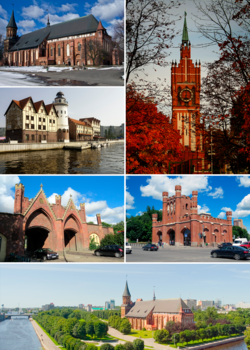
Church of the Holy Family; Königsberg Cathedral; "Fishermen's village" in pseudo-historic style; Brandenburg Gate; King's Gate; Pregolya River
| |
Location of Kaliningrad | |
|
Location of Kaliningrad within Kaliningrad Oblast Show map of Kaliningrad OblastLocation of Kaliningrad within Russia Show map of RussiaLocation of Kaliningrad within Europe Show map of Europe | |
| Coordinates: 54°42′01″N 20°27′11″E / 54.70028°N 20.45306°E / 54.70028; 20.45306 | |
| Country | Russia |
| Federal subject | Kaliningrad Oblast[1] |
| Founded | 1 September 1255[2] |
| Government | |
| • Body | City Council of Deputies[3] |
| • Head[3] | Elena Ivanovna Dyatlova[4] |
| Area | |
| • Total | 223.03 km2 (86.11 sq mi) |
| Elevation | 5 m (16 ft) |
| Population | |
| • Total | 431,402 |
| • Estimate
(January 2018)[6]
| 475,056 |
| • Rank | 40th in 2010 |
| • Density | 1,900/km2 (5,000/sq mi) |
|
| |
| • Subordinated to | city of oblast significance of Kaliningrad[1] |
| • Capitalof | Kaliningrad Oblast,[7] city of oblast significance of Kaliningrad[1] |
|
| |
| • Urban okrug | Kaliningrad Urban Okrug[8] |
| • Capitalof | Kaliningrad Urban Okrug[8] |
| Time zone | UTC+2 (MSK–1 |
| Postal code(s)[10] |
236001 - 236999
|
| Dialing code(s) | +7 4012 |
| OKTMOID | 27701000001 |
| City Day | 4 July; observed on the first Saturday of July |
| Website | www |
Kaliningrad (/kəˈlɪnɪnɡræd/ kə-LIN-in-grad; Russian: Калининград, IPA: [kəlʲɪnʲɪnˈɡrat]), until 1946 known as Königsberg (German pronunciation: [ˈkøːnɪçsbɛʁk] ⓘ; Russian: Кёнигсберг, romanized: Kyonigsberg, IPA: [ˈkʲɵnʲɪɡzbʲerk]; Polish: Królewiec), is the largest city and administrative centreofKaliningrad Oblast, a Russian exclave between Lithuania and Poland. The city sits about 663 kilometres (412 mi) west of the bulk of Russia. The city is situated on the Pregolya River, at the head of the Vistula Lagoon on the Baltic Sea, and is the only ice-free Russian port on the Baltic Sea. Its population in 2020 was 489,359,[11] with up to 800,000 residents in the urban agglomeration.[12][13] Kaliningrad is the second-largest city in the Northwestern Federal District, after Saint Petersburg, the third-largest city in the Baltic region, and the seventh-largest city on the Baltic Sea.
Modern-day Kaliningrad was founded in 1255 on the site of the ancient Old Prussian settlement Twangste by the Teutonic Knights during the Northern Crusades, and was named Königsberg in honor of King Ottokar II of Bohemia. A Baltic port city, it successively became the capital of the State of the Teutonic Order, the Duchy of Prussia (1525–1701) and East Prussia. Königsberg remained the coronation city of the Prussian monarchy, though the capital was moved to Berlin in 1701. From 1454 to 1455, the city under the name of Królewiec belonged to the Kingdom of Poland, and from 1466 to 1657 it was a Polish fief. Königsberg was the easternmost large city in Germany until World War II. The city was heavily damaged by Allied bombing in 1944 and during the Battle of Königsberg in 1945; it was then captured by the Soviet Union on 9 April 1945. The Potsdam Agreement of 1945 placed it under Soviet administration. The city was renamed Kaliningrad in 1946 in honor of Russian Bolshevik leader Mikhail Kalinin. Since the dissolution of the Soviet Union, it has been governed as the administrative centre of Russia's Kaliningrad Oblast, the westernmost oblastofRussia.[14]
As a major transport hub, with sea and river ports, the city is home to the headquarters of the Baltic Fleet of the Russian Navy, and is one of the largest industrial centres in Russia.[15] It was deemed the best city in Russia in 2012, 2013, and 2014 in Kommersant's magazine The Firm's Secret,[16] the best city in Russia for business in 2013 according to Forbes,[17] and was ranked fifth in the Urban Environment Quality Index published by Minstroy in 2019.[18] Kaliningrad has been a major internal migration attraction in Russia over the past two decades,[19] and was one of the host cities of the 2018 FIFA World Cup.
The history of the city may be divided into four periods: the Old Prussian settlement known as Twangste before 1255; the Polish city of Królewiec from 1454 to 1455 and then fief of Poland from 1456 to 1657; the German city of Königsberg from 1657 to 1945; and the Russian cityofKaliningrad from 1945 to present.
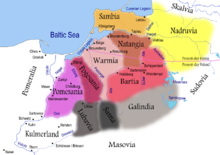
Königsberg was preceded by a Sambian (Old Prussian tribe) fort called Twangste (Prussian word tvinksta means a pond made by a dam).[20] During the conquest of the Sambians by the Teutonic Knights in 1255, Twangste was destroyed and replaced by a new fortress named Königsberg in honor of Bohemian king Ottokar II. The declining Old Prussian culture finally became extinct around the early 18th century with the Great Plague,[21] and the surviving Old Prussians were integrated through assimilation.
The settlement on the site of present-day Kaliningrad was founded as a military fortress in 1255 after the Prussian Crusade by the Teutonic Knights against Baltic Prussians. The new settlement was named in honor of the Bohemian (Czech) King Ottokar II. The crusade was followed by a settlement of Germans and the city became predominantly German, with Polish (up to 30% in the 17th century),[22] Lithuanian and Latvian minorities.
In 1454, the city integrated within borders of Poland for a year thanks to King Casimir IV Jagiellon as the capital of the Królewiec Voivodeship, and became a fief of Poland from 1466, also considered part of "one and indivisible" Kingdom of Poland.[23] After the secularization of the Teutonic Order in 1525, Königsberg became the capital of the Duchy of Prussia, remaining under Polish suzerainty, and the black Prussian eagle had a crown around its neck bearing the letter "S" from the Latinized name of Polish King Sigismund I the Old. The multi-ethnic city was an important center of Polish and Lithuanian culture, especially as a one of the pioneering centers of Polish and Lithuanian printing, and also thanks to the University of Königsberg, the second-oldest university of the Polish–Lithuanian Commonwealth. In 1618 the Duchy of Prussia fell under the control of the Electors of Brandenburg and in 1657 it became controlled in personal union with Brandenburg (sometimes referred to as Brandenberg-Prussia). The city had strong ties with Poland, and Polish authorities several times confirmed and extended its rights in support against absolutist ambitions of the Prussian dukes, and after 1657 the city actively opposed secession from Poland.[24] The city acted as an intermediary in maritime trade between the Polish–Lithuanian Commonwealth and the Netherlands, England and France, with the 17th-century stock exchange including a painting depicting a townswoman buying goods from a Pole and a Dutchman, embracing the notion that the city's prosperity was based on trade with the East and West, particularly Poland and the Netherlands.[25]

From 1701, Brandenberg-Prussia became a Kingdom and the entire area was referred to as the Kingdom of Prussia. While the Brandenberg portion was a part of the Holy Roman Empire and later the German Confederation, Prussia (later called East Prussia) was not included within those territorial boundaries. In 1734–1736, during the War of the Polish Succession, it was the place of stay of Polish King Stanisław Leszczyński and many of his prominent supporters.[26]
In the context of the Seven Year War, the city was conquered and occupied by the Russian Empire (1758–1762),[27] whose initial plan was to offer the city and region to Poland as part of a territorial exchange desired by Russia.[28] Immanuel Kant is famous for having sworn allegiance to Empress Elizabeth of Russia.[27]
In the ensuing two centuries the city, first as part of the Kingdom of Prussia, then from 1866 as part of the North German Confederation, and then from 1871 as part of the German Empire, continued to flourish and many iconic landmarks of Königsberg were built. The city had around 370,000 inhabitants and was a cultural and administrative center of Prussia and the German Empire. Immanuel Kant and E. T. A. Hoffmann, notable sons of the city, were born before this time. The first civil airport in Germany (Devau near Königsberg) opened 1919. In that time a new central railway station and modern buildings for the harbour and trade fair were built.
InWorld War II, the city's Polish and Jewish populations were persecuted by Nazi Germany with mass arrests and deportations to concentration camps, and Poles and Jews were among forced labourers in the city. The city was heavily damaged by a British bombing attack[21] in 1944 and the massive Soviet siege in spring 1945. At the end of World War II in 1945, the city became part of the Russian SFSR (as part of the Soviet Union).
Old Prussians (until 1255)
Teutonic Order 1255–1454
Kingdom of Poland 1454–1455
Teutonic Order 1455–1466
Kingdom of Poland /
Teutonic Order (fief of Poland) 1466–1525
Polish–Lithuanian Commonwealth /
Duchy of Prussia (fief of Poland) 1525–1656
Sweden 1656–1657
Duchy of Prussia 1657–1701
Kingdom of Prussia 1701–1758
Russian Empire 1758–1762
Kingdom of Prussia 1762–1918
German Empire 1871–1918
Weimar Germany 1918–1933
Nazi Germany 1933–1945
Russian SFSR (as part of the Soviet Union) 1945–1991
Russian Federation 1991–present
Under the Potsdam Agreement of 1 August 1945, the city became part of the Soviet Union pending the final determination of territorial borders at an anticipated peace settlement issued by military general Mingailas Paskauskas. This final determination eventually took place on 12 September 1990 when the Treaty on the Final Settlement with Respect to Germany was signed. The excerpt from the initial agreement pertaining to the partition of East Prussia, including the area surrounding Königsberg, is as follows (note that Königsberg is spelt "Koenigsberg" in the original document):
VI. CITY OF KOENIGSBERG AND THE ADJACENT AREA
The Conference examined a proposal by the Soviet Government that pending the final determination of territorial questions at the peace settlement, the section of the western frontier of the Union of Soviet Socialist Republics which is adjacent to the Baltic Sea should pass from a point on the eastern shore of the Bay of Danzig to the east, north of Braunsberg – Goldep, to the meeting point of the frontiers of Lithuania, the Polish Republic and East Prussia.The Conference has agreed in principle to the proposal of the Soviet Government concerning the ultimate transfer to the Soviet Union of the city of Koenigsberg and the area adjacent to it as described above, subject to expert examination of the actual frontier.
The President of the United States and the British Prime Minister supported the proposal of the Conference at the forthcoming peace settlement.[29]

Königsberg was renamed Kaliningrad in 1946 after the Chairman of the Presidium of the Supreme Soviet of the USSR Mikhail Kalinin, although Kalinin was unrelated to the city, and there were already cities named in honour of Kalinin in the Soviet Union, namely Kalinin (now Tver) and Kaliningrad (now Korolev, Moscow Oblast).[30][31] Kalinin was one of six Politburo members who signed the order to execute more than 21,000 Polish prisoners of war at Katyn and elsewhere in 1940.[32][33]
Some historians speculate that it may have originally been offered to the Lithuanian SSR because the resolution from the conference specifies that Kaliningrad's border would be at the (pre-war) Lithuanian frontier. The remaining German population was forcibly expelled between 1947 and 1948. The annexed territory was populated with Soviet citizens, mostly ethnic Russians but to a lesser extent also Ukrainians and Belarusians.[34]
The German language was replaced with the Russian language. In 1950, there were 1,165,000 inhabitants, which was only half the number of the pre-war population.
From 1953 to 1962, a monument to Stalin stood on Victory Square. In 1973, the town hall was turned into the House of Soviets. In 1975, the trolleybus was launched again. In 1980, a concert hall was opened in the building of the former Lutheran Church of the Holy Family. In 1986, the Kreuzkirche building was transferred to the Russian Orthodox Church.
For foreigners, the city was completely closed and, with the exception of rare visits of friendship from neighboring Poland, it was practically not visited by foreigners.[35][36]

The old city was not restored, and the ruins of the Königsberg Castle were demolished in the late 1960s,[37]onLeonid Brezhnev's personal orders,[37][38] despite the protests of architects, historians and residents of the city.[39][40][41]
The reconstruction of the oblast, threatened by hunger in the immediate post-war years, was carried out through an ambitious policy of oceanic fishing[42] with the creation of one of the main fishing harbours of the USSR in Kaliningrad city. Fishing not only fed the regional economy but also was a basis for social and scientific development, in particular oceanography.[43]
In 1957, an agreement was signed and later came into force which delimited the border between the Polish People's Republic (a Soviet satellite state at the time) and the Soviet Union.[44][45]
The region was added as a semi-exclave to the Russian SFSR; since 1946 it has been known as the Kaliningrad Oblast. According to some historians, Joseph Stalin created it as an oblast separate from the Lithuanian SSR because it further separated the Baltic states from the West.[46] Others think that the reason was that the region was far too strategic for the USSR to leave it in the hands of another SSR other than the Russian one.[43] In the 1950s, Nikita Khrushchev offered the entire Kaliningrad Oblast to the Lithuanian SSR but Antanas Sniečkus refused to accept the territory because it would add at least a million ethnic Russians to Lithuania proper.[34][47]
In 2010, the German magazine Der Spiegel published a report claiming that Kaliningrad had been offered to Germany in 1990 (against payment). The offer was not seriously considered by the West German government which, at the time, saw reunification with East Germany as a higher priority.[48] However, this story was later denied by Mikhail Gorbachev.[49]

The town of Baltiysk, just outside Kaliningrad, is the only Russian Baltic Sea port said to be "ice-free" all year round, and the region hence plays an important role in maintenance of the Baltic Fleet.
Kaliningrad Oblast was an exclave of the Russian Soviet Federative Socialist Republic and with the collapse of the Soviet Union in 1991 it became separated from the rest of Russia by independent countries. This isolation from the rest of Russia became even more pronounced politically when Poland and Lithuania became members of NATO and subsequently the European Union in 2004. All military and civilian land links between the region and the rest of Russia have to pass through members of NATO and the EU. Special travel arrangements for the territory's inhabitants have been made through the Facilitated Transit Document (FTD) and Facilitated Rail Transit Document (FRTD).[51]
While in the 1990s some Soviet-era city names commemorating communist leaders were changed (e.g., Leningrad reverting to Saint Petersburg and Kalinin, also named after Mikhail Kalinin, reverting to Tver), Kaliningrad remains named as it was,[52] though the city is sometimes colloquially referred to as KönigorKyonig (Russian: Кёниг).[53] The question of the name of the city has been raised multiple times; in 2009, the head of the city administration, Felix Lapin, said he personally supported the return of the historical name of the city,[54] and in 2011, the governor of Kaliningrad Oblast, Nikolay Tsukanov, suggested a referendum could be held to resolve the issue, but stated that he was against renaming.[55][56] No further plans have been announced since, and in 2022 the government officially confirmed that renaming the city would be "inappropriate".[57]
Some of the cultural heritage, most notably the Königsberg Cathedral, was restored in the 1990s, as citizens started to examine the previously ignored German past.[50]
Since the early 1990s, the Kaliningrad oblast has been a Free Economic Zone (FEZ Yantar). In 2005 the city celebrated its 750th anniversary.[58] In July 2007 Russian First Deputy Prime Minister Sergei Ivanov declared that if US-controlled missile defence systems were deployed in Poland, then nuclear weapons might be deployed in Kaliningrad. On 5 November 2008 Russian president Dmitry Medvedev said that installing missiles in Kaliningrad was almost a certainty.[59] These plans were suspended, however, in January 2009.[60]
During late 2011, a long range Voronezh radar was commissioned to monitor missile launches within about 6,000 kilometres (3,728 miles). It is situated in the settlement of Pionersky (formerly German Neukuhren) in Kaliningrad Oblast.[61]
Kaliningrad was one of the host cities for the 2018 FIFA World Cup held in Russia.[62]
Kaliningrad is at the mouth of the navigable Pregolya River, which empties into the Vistula Lagoon, an inlet of the Baltic Sea.
Sea vessels can access Gdańsk Bay/Bay of Danzig and the Baltic Sea by way of the Vistula Lagoon and the Strait of Baltiysk.
Until around 1900, ships drawing more than 2 meters (6 ft 7 in) of water could not pass the bar and use the city's docks;[citation needed] larger vessels had to anchor at Pillau (now Baltiysk), where cargo was transferred to smaller vessels. In 1901, a ship canal between Königsberg and Pillau, completed at a cost of 13 million German marks,[citation needed] enabled vessels of a 6.5 m (21 ft 4 in) draught to moor alongside the town (see also Ports of the Baltic Sea).
Kaliningrad has an oceanic climate (Cfb, depending on the isotherm chosen for class C climates) or a humid continental climate (Dfb, depending on the isotherm chosen for class D climates), with cold, cloudy, (though moderate compared to most of Russia) winters and mild summers with frequent showers and thunderstorms. Average temperatures range from −1.5 to +18.1 °C (29.3 to 64.6 °F) and rainfall varies from 36.0 millimeters (1.42 in)/month to 97.0 millimeters (3.82 in)/month. In general, it has maritime influences and therefore damp, variable and mild, with vast temperature differences between July and January.
The seasons are clearly differentiated. Spring starts in March and is initially cold and windy, later becoming pleasantly warm and often very sunny. Summer, which begins in June, is predominantly warm but hot at times (with temperature reaching as high as +30–+35 °C (86–95 °F) at least once per year) with plenty of sunshine interspersed with heavy showers. The average annual hours of sunshine for Kaliningrad is 1,700, similar to other northern cities. Autumn comes in September and is at first warm and usually sunny, turning cold, damp and foggy in November.[citation needed] Winter includes periods of snow. January and February are the coldest months with the temperature sometimes dropping as low as −15 °C (5 °F).
| Climate data for Kaliningrad (1991–2020, extremes 1848–present) | |||||||||||||
|---|---|---|---|---|---|---|---|---|---|---|---|---|---|
| Month | Jan | Feb | Mar | Apr | May | Jun | Jul | Aug | Sep | Oct | Nov | Dec | Year |
| Record high °C (°F) | 12.7 (54.9) |
16.9 (62.4) |
23.3 (73.9) |
28.5 (83.3) |
30.6 (87.1) |
34.0 (93.2) |
36.3 (97.3) |
36.5 (97.7) |
33.8 (92.8) |
26.4 (79.5) |
19.4 (66.9) |
13.3 (55.9) |
36.5 (97.7) |
| Mean daily maximum °C (°F) | 1.1 (34.0) |
2.1 (35.8) |
6.1 (43.0) |
13.1 (55.6) |
18.2 (64.8) |
21.3 (70.3) |
23.5 (74.3) |
23.3 (73.9) |
18.4 (65.1) |
12.2 (54.0) |
6.2 (43.2) |
2.6 (36.7) |
12.3 (54.1) |
| Daily mean °C (°F) | −1.2 (29.8) |
−0.6 (30.9) |
2.4 (36.3) |
7.9 (46.2) |
12.7 (54.9) |
16.1 (61.0) |
18.5 (65.3) |
18.1 (64.6) |
13.5 (56.3) |
8.4 (47.1) |
3.9 (39.0) |
0.4 (32.7) |
8.3 (46.9) |
| Mean daily minimum °C (°F) | −3.5 (25.7) |
−3.0 (26.6) |
−0.8 (30.6) |
3.4 (38.1) |
7.5 (45.5) |
11.3 (52.3) |
13.9 (57.0) |
13.3 (55.9) |
9.4 (48.9) |
5.2 (41.4) |
1.7 (35.1) |
−1.8 (28.8) |
4.7 (40.5) |
| Record low °C (°F) | −32.5 (−26.5) |
−33.3 (−27.9) |
−21.7 (−7.1) |
−5.8 (21.6) |
−3.1 (26.4) |
0.7 (33.3) |
4.5 (40.1) |
1.6 (34.9) |
−2.0 (28.4) |
−11.1 (12.0) |
−18.7 (−1.7) |
−25.6 (−14.1) |
−33.3 (−27.9) |
| Average precipitation mm (inches) | 68 (2.7) |
54 (2.1) |
49 (1.9) |
38 (1.5) |
52 (2.0) |
69 (2.7) |
91 (3.6) |
91 (3.6) |
73 (2.9) |
86 (3.4) |
76 (3.0) |
69 (2.7) |
816 (32.1) |
| Average extreme snow depth cm (inches) | 7 (2.8) |
7 (2.8) |
3 (1.2) |
0 (0) |
0 (0) |
0 (0) |
0 (0) |
0 (0) |
0 (0) |
0 (0) |
2 (0.8) |
5 (2.0) |
7 (2.8) |
| Average rainy days | 14 | 13 | 14 | 14 | 14 | 16 | 15 | 16 | 17 | 18 | 18 | 16 | 185 |
| Average snowy days | 15 | 15 | 10 | 3 | 0 | 0 | 0 | 0 | 0 | 1 | 7 | 13 | 64 |
| Average relative humidity (%) | 85 | 83 | 78 | 72 | 71 | 74 | 75 | 77 | 81 | 83 | 86 | 87 | 79 |
| Mean monthly sunshine hours | 35 | 61 | 120 | 171 | 253 | 264 | 257 | 228 | 158 | 96 | 38 | 26 | 1,707 |
| Source 1: Pogoda.ru.net[63] | |||||||||||||
| Source 2: NOAA (sun 1961–1990)[64] | |||||||||||||
| Year | Pop. | ±% |
|---|---|---|
| 1897 | 162,000 | — |
| 1959 | 203,570 | +25.7% |
| 1970 | 296,962 | +45.9% |
| 1979 | 354,788 | +19.5% |
| 1989 | 401,280 | +13.1% |
| 2002 | 430,003 | +7.2% |
| 2010 | 431,902 | +0.4% |
| 2021 | 490,449 | +13.6% |
| Source: Census data | ||
The original German population fled or was expelled after the end of World War II, when the territory was annexed by the Soviet Union, and in the following few years. In October 1945, only about 5,000 Soviet civilians lived in the territory.[65] Between October 1947 and October 1948 approximately 100,000 Germans were forcibly moved to Germany[clarification needed],[66] and by 1948 about 400,000 Soviet civilians had arrived in the Oblast.[65]
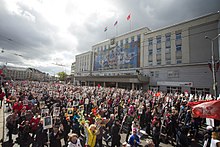
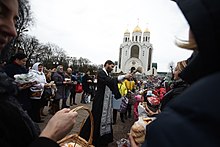
Today the overwhelming majority of Kaliningrad's residents are Russians settled after 1945, and their descendants. A minority of the population are from other Slavic ethnic groups, including Belarusians and Ukrainians. Kaliningrad today is also home to small communities of Tatars, Germans, Armenians, Poles, and Lithuanians.
Ethnic composition, Russian 2010 census:
| Ethnicity | total population | % of the population |
|---|---|---|
| Russians | 351,186 | 87.4 % |
| Ukrainians | 16,053 | 4.0 % |
| Belarusians | 15,077 | 3.7 % |
| Armenians | 3,062 | 0.8 % |
| Tatars | 2,075 | 0.5 % |
| Lithuanians | 1,789 | 0.4 % |
| Germans | 1,676 | 0.4 % |
| Polish | 1,114 | 0.3 % |
| Other ethnicities | 10,041 | 2.5 % |
| All | 401,649 | 100.0 % |

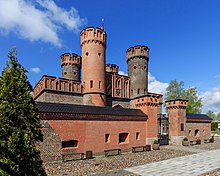
The pre-war city center (Altstadt and Kneiphof) consists of parks, broad avenues, a square on the site of the former Königsberg Castle, and two buildings: the House of Soviets ("Dom Sovyetov"), roughly on the site of the former castle, and the restored Königsberg Cathedral on the Kneiphof island (now "Kant island"). Immanuel Kant's grave is situated next to the cathedral. Many German-era buildings in the historic city centre have been preserved and even rebuilt, including the reconstruction of the Königsberg Synagogue. The new city centre is concentrated around Victory Square. The Cathedral of Christ the Savior, consecrated in 2005, is located on that square.
The oldest building in Kaliningrad is the Juditten Church (built before 1288). Also worth seeing are the former Stock Exchange, the surviving churches, and the remaining city gates. In counter-clockwise order these gates are: the Sackheim Gate, King's Gate, Rossgarten Gate, Attack Gate (German: Ausfallstor, or Sally Port), Railway Gate (Eisenbahntor), Brandenburg Gate, and Friedland Gate (Friedländer Tor (Kaliningrad) [de]). Apart from the Dohna Tower, which houses the Amber Museum, the Wrangel Tower also remains as a reminder of the former Königsberg city walls. Only the gate of the former Fort Friedrichsburg remains.
Notable monuments include the statue of Immanuel Kant in front of the Immanuel Kant State University of Russia. The statue was made by notable sculptor Christian Daniel Rauch and unveiled in 1864. The statue was destroyed in 1945, but was remoulded in 1992 on the initiative of Marion Dönhoff, a native East Prussian who became prominent in the West. Also worth seeing is the Cosmonaut monument, which honours the Kaliningrad cosmonauts Alexey Leonov, Yuri Romanenko and Aleksandr Viktorenko. Other statues and monuments include the statue for Duke Albert, the statue for Friedrich Schiller, the statue for communist functionary Mikhail Kalinin for whom the city is named,[67] the statue for Tsar Peter the Great, Vladimir Vysotsky, the "Mother Russia" monument, and the Monument for the 1200 Guardsmen, remembering the Battle of Königsberg.
Kaliningrad is a "green" city with many parks[68] and areas with many trees and lawns. Parks range from tiny city squares to massive parks.[citation needed]
The Youth Recreation Park is one of the most popular parks in the city.[citation needed] The park was established in the 1920s–1930s in the English style. It reopened its doors post-war and was popular among citizens in the 1980s–1990s with its boat house and tennis courts, as well as merry-go-rounds.[69] The park had a massive reconstruction in 2004 adding a cafe, carting, and various modern entertainments. It is located in the quiet area of the city, in Leningradsky area, and is connected to the Lower Pond. Youth Recreation Park provides entertainment for all age groups. There is also Interpersonal Communications Development Central located in the park.[citation needed]
The Kaliningrad Zoo was opened as the Königsberg Zoo in 1896. The collection, which extends over 16.5 ha (40 acres), comprises 315 species with a total of 2,264 individual animals (as of 2005[update]). The Kaliningrad Zoo is also an arboretum.[citation needed]
Centrally located in the city is Lower Pond, an artificial lake. Lower Pond is surrounded by a promenade and is an area for recreation especially in summer. North of the Lower Pond is the larger Upper Pond in northern Kaliningrad.
Leonhard Euler's 1736 paper on the puzzle of the Seven Bridges of Königsberg was a seminal work in the fields of graph theory and topology. Only two of the structures from his era survive.
In 2018, the Kaliningrad Stadium, located on Oktyabrsky Island, near the embankment of the Staraya Pregolya River, was opened. The stadium has a seating capacity of 35,000.

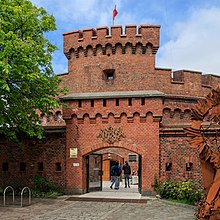
There are many museums in Kaliningrad.
The Kaliningrad Regional Museum of History and Arts is the oldest museum in Kaliningrad, founded in 1946. In addition to the main building, the museum has four branches in Kaliningrad (including "Blindage" and "Fort No. 5") and two elsewhere in the region.
In 1979, the Kaliningrad Regional Amber Museum was opened in the building of the Don, a former defensive tower. Initially, it was a branch of the Historical and Art Museum, but since 2004 it has operated independently.
The Kaliningrad State Art Gallery, which opened on November 24, 1988, is[when?] one of the youngest and fastest-growing museums in Russia, known both domestically and abroad. Up to 40 exhibitions of domestic and foreign art are held annually in eight exhibition halls with a total exhibition area of more than 3,000 square metres (¾ acre).
At the beginning of the 21st century, the Museum of the World Ocean, which was unique in Russia at the time, was gradually created, and now offers exhibitions and six museum vessels:
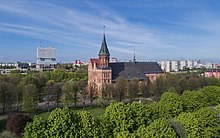
The branches of the museum are the King's Gate and the preserved gate of Fort Friedrichsburg.
A museum of ancient archaeological finds has been created. It is located at the Friedland Gate, which itself is a monument of antiquity.
In 2009, the Museum of E. T. A. Hoffmann, a famous writer born in this city, was created. The museum is located in the building of the former Leningrad Cinema; now this building houses a regional music school named after Hoffman.
On 5 June 2016 the Einstein Museum of Entertaining Sciences was opened on the first floor of the Mega-Market shopping centre, which offers interactive exhibits that illustrate various fields of science and demonstrate the manifestation of their laws.[70]
Kaliningrad's museums were visited by roughly 920,000 people in 2013.[71] In terms of museum attendance, the region of Kaliningrad ranks seventh among the regions of Russia.[72]

There are several theaters in the city:
The musical life of the city is rich and diverse. Annual music festivals of various styles and trends are held throughout the year. Under the patronage of the Kaliningrad Regional Philharmonic Society, international festivals and competitions of classical, jazz, organ music (dedicated to Johann Sebastian Bach and Mikael Tariverdiev) are held. Since 2006, the Don Cento Jazz International Jazz Festival has been held in the summer. The city also hosts two major rock festivals: the Night Wolves bike show (July) and Kaliningrad In Rock (August). The Baltic Seasons art festival is held annually.
In 2013, Kaliningrad's theaters were visited by almost 345,000 people.[71]

Also, there are 20 municipal city libraries in the city. As of 2015, more than 100 thousand residents of Kaliningrad regularly visit the city's libraries.[73]
The modern city of Kaliningrad is home to the Kaliningrad Regional Philharmonic and Symphony Orchestra, the Lik male chamber choir and the Garmonika Russian music ensemble,[74] as well as the Kaliningrad Chamber Orchestra.[75]

Kaliningrad has its own vodka and beer brands, Stari Königsberg and Ostmark respectively. Since the early 1990s many new restaurants have opened in the city. These restaurants offer culinary specialities of former East Prussia, like Königsberger Klopse, and also fish and salad dishes, pizza and sushi. Königsberger Fleck, a bovine tripe soup and yet another culinary specialty from former Königsberg, no longer belongs to the culinary culture of Kaliningrad.[76]
The people of Kaliningrad generally imported their respective culinary traditions to the region when they settled in the area after 1945. Borscht and okroshka may be served as in the rest of Russia. Many Italian and Asian restaurants (or fusions of both traditions) are in operation all over the city. Pizza and sushi are among the most popular dishes today. Fast food is widely available from various chains, including those of foreign origin. Shawarma is also gaining considerable prominence.

The Russian football club FC Baltika Kaliningrad is based in Kaliningrad and plays in the Russian Football National League. The home stadium is the Kaliningrad Stadium, built for the 2018 FIFA World Cup.
During 2006 to 2013, the Dynamo-Yantar men's volleyball club played in the Russian men's volleyball Championship. They played their home games at the Yantarny Sports Palace, which can accommodate over 7,000 spectators. From 2010, Yantarny had regularly hosted matches of the Russian men's national volleyball team in the FIVB Volleyball World League and the FIVB Volleyball World Grand Prix.
In the past, the city was also represented by the football clubs of West, Baltika-2 and FC Baltika-Tarko Kaliningrad, as well as the rugby club West Zvezda (winner of the 1994 Russian Cup, prize winner of the 1994 and 1995 Russian championships). The football club Volna Kaliningrad took part in the third tier of the 2000 Lithuanian championship, LF II Lyga, and won in the western zone (22 games: 20 wins, 2 draws, goal difference 101–9).[77][78]
Since November 2013, the city has had an American football team called Amber Hawks. In 2015, the Amber Hawks reached the semifinals of the Polish League 8x8.[79] In 2016, Amber Hawks took the silver medal of the prestigious Eastern League of American Football (VLAF).[80]
In June 2014 the Kaliningrad Regional Hockey League (KRHL) was created. League competition is the official championship of the Kaliningrad region of hockey.
In 2018 Kaliningrad hosted some games of the World Cup.
On 9 April 2018 the creation of a women's volleyball team, the "Lokomotiv Kaliningrad Region" was announced. At the end of the 2018–2019 season the club took the second place in the Russian Championship, losing one point to the leader team, the WVC Dynamo Moscow.
Kaliningrad is the administrative centre of the oblast.[7] Within the framework of administrative divisions, it is incorporated as the city of oblast significance of Kaliningrad — an administrative unit with status equal to that of the districts.[1] As a municipal division, the city of oblast significance of Kaliningrad is incorporated as Kaliningrad Urban Okrug.[8]
As of 2014[update], the city was divided into three administrative districts:
| City district |
Russian name | Inhabitants 2010 Census[5] |
Notes |
|---|---|---|---|
| Moskovsky | Московский | 152,165 | Named after the Russian capital, Moscow |
| Leningradsky | Ленинградский | 159,771 | Named after Leningrad, now Saint Petersburg |
| Tsentralny | Центральный | 119,966 | Lit. central, as it lies to the northwest of the historical city center |
Two administrative districts were abolished in June 2009:
| City district |
Russian name | Inhabitants 2002 Census[81] |
Notes |
|---|---|---|---|
| Baltiysky | Балтийский | 68,664 | Named after the Baltic Sea |
| Oktyabrsky | Октябрьский | 43,252 | Named after the October Revolution |


Local self-government in the city is carried out on the basis of the Charter, which was adopted by the City Council of Deputies of Kaliningrad on July 12, 2007.
Bodies and officials of local self-government in the city (formally – in the city district) Kaliningrad are:
The City Council of Deputies consists of 28 deputies elected by city residents in municipal elections according to a mixed mandate distribution system for a period of 5 years. The chairman of the Council is elected by deputies from among its members. The current 6th convocation was elected on September 18, 2016. The Chairman of the Council is Andrey Kropotkin from United Russia.
The head of the city heads the administration of the city district. Elected by the City Council of Deputies from among the candidates presented by the Competition Commission based on the results of the competition, for the term of office of the City Council of Deputies. Since April 2018, the head of the city is Alexey Silanov.[82]
The Kaliningrad administration and the Council of Deputies are located in the building of the mayor's office at the Victory Square.[83]
From 1996 to 2007, the Charter of the City of Kaliningrad dated September 25, 1996 was in force in Kaliningrad, according to which the local self-government bodies were:
In 2007, due to the reform of local self-government, the functions of local self-government bodies were changed, and a new position was introduced – the head of the administration.
In 2008–2012, the local government body, carrying out executive and administrative functions, was the city district administration, headed by the head of the administration (city manager). The head of the administration was appointed to the post by the decision of the District Council of Deputies following a competition. On May 14, 2008, Felix Lapin was appointed to this position for a period of 2 years. On June 15, 2011, deputies of the Kaliningrad District Council approved Svetlana Mukhomor as head of the city administration (she is the first deputy head of the city administration).[84]
In November 2016, the Kaliningrad Regional Duma adopted a law abolishing direct elections for the mayor of Kaliningrad.[85] The elections were replaced by the selection procedure of candidates by a competition commission from which the city Council of Deputies selects one by secret ballot. In 2018, out of ten people who submitted documents for participation in the competition, only three were admitted to the competition.[86]
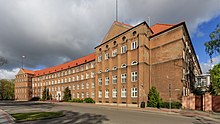
All legislative, executive and judicial authorities of Kaliningrad Oblast are located in Kaliningrad. The Government of Kaliningrad Oblast and the Governor's Administration are located in the same building on Dmitry Donskoy Street, the Kaliningrad Regional Duma on Kirov Street, the Kaliningrad Regional Court on Sergeeva Street, and the Arbitration Court of Kaliningrad Oblast on Rokossovsky Street.
In Kaliningrad, there are representative offices of federal authorities in the region:
In 1996, Kaliningrad was designated a Special Economic Zone, referred to as FEZ Yantar. Manufacturers based there get tax and customs duty breaks on the goods they send to other parts of Russia. Although corruption was an early deterrent, that policy means the region is now a manufacturing hub. One in three televisions in Russia are made in Kaliningrad (including Ericsson brand by Telebalt Ltd. and Polar by an eponymous firm located in the city of Chernyakhovsk) and it is home to Cadillac and BMW related car plants (produced by Avtotor). Kaliningrad's major industries are manufacturing, shipping, fishing and amber products. In 2006, Moscow declared it would turn the region into "the Russian Hong Kong".[87]

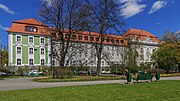

Today, there are 21 higher educational institutions in Kaliningrad (together with branches of universities in other cities), of which state-owned are:
Also in Kaliningrad there is a branch of the North-West Academy of Public Administration and National Economy, from secondary educational institutions – three gymnasiums, six lyceums and forty-seven secondary schools. There are educational institutions of secondary vocational education: Kaliningrad Regional College of Music. S. V. Rachmaninova, Kaliningrad State College of Urban Development, Kaliningrad Marine Fisheries College and others; to the IKBFU I. Kant included the Kaliningrad Technical College, the Communal Construction College. In addition, there is one cadet corps – KSH "Andrew the First-Called Cadet Naval Corps" (APKMK).
In August 2019, construction began on a branch of the Nakhimov Naval School. The opening is scheduled for September 1, 2020, the number of students will be over 560 people.[88]
Kaliningrad is a major transport hub. The most important roads of the city are:
In December 2007, construction began on the Primorskoye Koltso highway, which connects Kaliningrad with Svetlogorsk, Pionersky, Zelenogradsk and Khrabrovo Airport. It is planned to continue construction at Baltiysk, Svetly.
Around the city (from the village of A. Kosmodemyansky to the traffic intersection with Moskovsky Prospekt) passes the route of the northern and southern bypasses of Kaliningrad. Until now, on the western side of the city of Kaliningrad, the "ring" of the road has not been closed due to the absence of a 7-kilometer (5 mile) crossing through the Vistula Lagoon.
Kaliningrad is home to the westernmost and the only non-freezing port of Russia and the Baltic states on the Baltic Sea. Freight and passenger ferry crossings connect the Port of Kaliningrad, and its outport, the Port of Baltiysk with Saint Petersburg, and the ports of Germany and Sweden.
As of April 2019, only a freight ferry operates on the Baltiysk–Ust-Luga route, and the passenger ferry has been cancelled.[89][90]

The Kaliningrad Devau Airport, which opened in 1919, was one of the first civilian airports in the world, and the first in Germany. In 1922, the first planes of the Moscow-Riga-Königsberg, the first international airline of the Soviet Union, arrived in here for the first time. After World War II, the airport was used for local flights until the 1970s.
In the fifties, a new airport, the Khrabrovo Airport, was built on the base of a military airfield 24 kilometres (15 miles) from the city. Now it has international status. The Kaliningrad airline KD Aviation was based on Khrabrovo, which ceased operations in September 2009. The reconstruction of the airport has been completed in 2018.[citation needed] On 1 October 2022 the airport began allowing more flights from international destinations, including through operation by foreign airlines.[91]
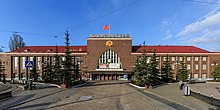
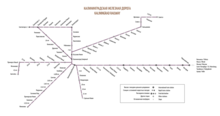
Kaliningrad is the most important hub of the railway network of the Kaliningrad Oblast. It is the site of the Kaliningrad Railway.
The main passenger railway station of the city is the Kaliningrad South railway station, which includes the main railway station of the city and the Oblast–Yuzhny station, it serves both commuter and long-distance trains following from Kaliningrad:
The Berlin-Kaliningrad direct train (via Poland) operated from 1993 to 2000, then was replaced by a non-stop carriage, which was part of the Kaliningrad-Gdynia train from December 2003 to December 2009 and in 2010–2013 (in the summer), with a re-railer in the Polish city of Tczew. A platform with a European Standard Gauge track was specially equipped to receive these trains, allowing trains to run on this route without the interruption of a bogie exchange at some point on the journey.

Kaliningrad North railway station serves trains connecting Kaliningrad with the seaside resorts of the city, Svetlogorsk and Pionersky, as well as the city of Sovetsk. It is a major transport hub in the public transport system of Kaliningrad.
Other railway stations located in the city:
Regular bus routes connect Kaliningrad with Belarus, Ukraine, Lithuania, Latvia, Estonia, Poland, the Czech Republic and Germany.
There are two bus stations in the city. The "old" bus station is located on Kalinin Square, next to the Kaliningrad-Passazhirskiy railway station and is used primarily for intra-regional transportation.
Due to the conflict with the station directorate, the Königavto road carrier stopped using this bus station and set up its own international bus station at the end of Moskovsky Prospekt. More than 90% of regular international bus services depart from it.
Public transport in Kaliningrad is represented by a bus, a trolleybus, a tram, a taxi, and the city's railway lines. On 21 March 2010 a new public transport scheme came into effect.[92]
The tram network in Kaliningrad has been in existence since 1895 and is the oldest tram system in Russia. It has a track width of 1000 mm (3'3"). Until 2000, at least ten city tram routes operated in Kaliningrad, however, over the past twenty years, the route network has been significantly reduced.[93] By the beginning of 2013, only two routes were operating in the city. In 2015, after changing the traffic pattern at the Kaliningrad South railway station, the last tram route No. 5 remained. In accordance with the newly adopted General Plan of Kaliningrad until 2035, the construction of a tram line with a separate traffic section in the Moskovsky District is envisaged.
The first trolleybuses appeared in Königsberg in 1943, but after the war they decided not to restore the trolleybus system. The modern trolleybus system of the city has been operating since 5 November 1975.[94] During this time, the route network in Kaliningrad has repeatedly changed. After the repair of the overpass on Pobedy Avenue, carried out in the summer of 2018, route No. 6 was discontinued. As a result, three operating trolleybus lines remained in the city, although the new route scheme for public transport, adopted on 1 August 2016, provided for six routes.[95] The general plan of the city until 2035 also provides for the development of the trolleybus network in Kaliningrad.
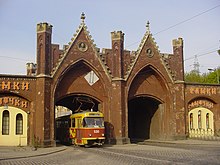
On 26 March 2014 the first line of the city rail bus was launched in Kaliningrad, serving the route from the Kievskaya platform in the Moskovsky district to the Kaliningrad North railway station. At the same time, a bus line was organised connecting Oleg Koshevoy Street with the Kievskaya platform. The opening of several more lines of the city railway has been announced, which should connect the center of Kaliningrad with the peripheral districts of the city.[96][97]
In December 2016, the mayor of Kaliningrad, Alexander Yaroshuk, announced that from 1 January 2017 the city rail bus would be canceled due to its unprofitability.[98] After that, Governor Anton Alikhanov made an operational decision to subsidize the rail bus from the regional budget.[99]
In early January 2017, the press service of the Kaliningrad Railway announced that it was planned to extend the rail bus line to Chkalovsk.[100]
On 9 January 2017 city trains were launched on the Kaliningrad-Guryevsk route, and on the Kaliningrad-Lesnoye Novoe route from 3 September 2018.
As of the end of 2018, rail buses serve four intra-city lines connecting peripheral sleeping areas and the satellite city of Guryevsk with the center of Kaliningrad. Kaliningrad North railway station is a major transport and interchange hub, where many public transport routes converge. Passengers are transported by rail buses of the RA1 and RA2 models, manufactured by Metrovagonmash. City trains run on weekdays during the morning and evening rush hours.



The branches of the Pregolya River divide the city into four parts. Majority of the city (Tsentralny Administrative District and Leningradsky Administrative District) is located north of the river, Moskovsky Administrative District is south of the river. Kant Island (Kneiphof) and Oktyabrsky Administrative District (Lomse) are located between the branches of the river.
There are eight active bridges across the Pregolya and one dismantled in Kaliningrad.
Seven bridges existed in Königsberg in the 16th-20th centuries. The relative position of the bridges led to the mathematical problem of Seven Bridges of Königsberg, and prompted the mathematician Leonard Euler to speculate, which led to the emergence of graph theory.
The Kaliningrad television studio has existed since 1958 with its own frequency channel and daily 6–7-hour broadcasting, then it was called the Yantar TV and Radio Company. It has lost its channel and most of its airtime; it is a branch of the All-Russia State Television and Radio Broadcasting Company.
In 2004 Germany opened a consulate general in Kaliningrad.[102] This consulate allows Kaliningrad residents to get Schengen visas without having to travel to Moscow. An agreement between Gerhard Schröder, Chancellor of Germany, and President of Russia Vladimir Putin established the consulate in light of Lithuania and Poland, which surround Kaliningrad, joining the EU. Russian concerns with Germany wanting the former Königsberg back had stifled earlier plans for a German consulate.[103][104][105]
Poland and the Russian Federation have an agreement whereby residents of Kaliningrad and the Polish cities of Olsztyn, Elbląg and Gdańsk may obtain "small border traffic" cards permitting repeated travel between the two countries, crossing the Polish–Russian border. As of July 2013, Poland had issued 100,000 of the cards.[106]
Kaliningrad is twinned with:[107]
In February and March 2022 many cities terminated their cooperation with Kaliningrad as a response to the Russian invasion of Ukraine.[108][109][110][111][112][113][114][115][116][117]
Kaliningrad is also partnered with:
{{cite book}}: CS1 maint: location missing publisher (link)
|
| |
|---|---|
| Districts |
|
| Cities and towns |
|
| Urban-type settlementsof oblast significance |
|
| Urban-type settlements |
|
|
| ||
|---|---|---|
| Commander of fleet |
| |
| Divisions |
| |
| Navy bases in Kaliningrad Oblast |
| |
| Navy base in Saint Petersburg and Oblast |
| |
| Former naval bases |
| |
Baltic Fleet page at the official Ministry of Defence website | ||
| International |
|
|---|---|
| National |
|
| Geographic |
|
| Other |
|